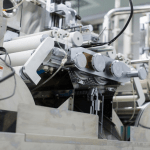Have you ever taken a moment to consider the abundance of plastic items that surround you in your routine? From casings, for household gadgets to computer mouse devices and water bottles plastic products seem to be. It’s undeniable that plastic has become a used material in today’s world. This article will guide you through the process of injection molding detailing each step from conception to production.
WHAT IS PLASTIC INJECTION MOLDING?
A typical injection molding cycle lasts anywhere from six to two minutes. The process involves stages:
Clamping: Prior to injecting the plastic into the mold the two halves of the mold must be securely shut using the clamping mechanism. The clamping unit exerts pressure to ensure that the mold remains tightly sealed while the material is injected. The time needed for mold closure and clamping varies based on machine size; larger machines with openings require time.
Injection: Raw plastic material in pellet form is introduced into the injection molding machine. Guided towards the mold by the injection unit. As the screw pushes the pellets through zones within the machine barrel they are heated up due to both temperature and compression.
Cooling: The molten plastic inside the mold cools as soon as it comes into touch with the internal mold surfaces. The chilling process strengthens the shape and rigidity of the newly molded plastic component. It’s vital to note that part shrinkage can happen throughout the cooling process. The cooling time required for each plastic molded item are determined by the plastic’s thermodynamic properties, wall thickness, and completed part dimensions.
Ejection: The ejection mechanism removes the part from the mold as it cools down. Injection molding machines use force for this purpose. Once a part is ejected a fresh batch of plastic is prepared for molding while making way for another part, in line.
By opting for injection molding services you can expect turnaround times without compromising on quality or precision in your parts.
WHAT HAPPENS AFTER PLASTIC INJECTION MOLDING?
It’s typical to perform finishing operations on the injection molding process.
When considering design choices factors, like aesthetics or functionality may influence the use of manufacturing techniques. Options such as welding, heat staking, pad printing and laser marking are commonly considered in this regard.
How do experts categorize plastic injection molding machines? Knowing the approximate size of the press required to produce your precise components is critical in selecting the injection molding service based on available press capacity. For example, larger presses cannot fit smaller molds due to their excessive shot capacity.
Plastic injection molding machines are categorized based on their tonnage clamping pressure or force. These machines vary in size from under 5 tons of clamping pressure to over 4000 tons. The machine’s size increases with a higher ton rating. A machine rated at 400 tons can provide 400 tons of clamping pressure for keeping the mold closed during the injection process; insufficient or excessive pressure could lead to quality issues.
WHY PLASTIC MOLDING?
Plastic injection molding is ideal for manufacturing many parts and products because of its aesthetic and practical adaptability. Advantages include:
- Injection molding is simple and highly mechanized, making it efficient. This reduces production time, which can increase revenue and save money.
- Plastic is strong but lighter than metal or other common part materials. Therefore, many manufacturers consider metal to plastic conversion a good choice for replacing metal or steel parts with plastic.
- Injection molding produces precise, uniform parts.
- This process is good for simple products, but it’s also good for complex or finely detailed parts and when precise part specifications are required.
- Color manufacturers can create almost any shade or visual effect.
- More than 15,000 polymers are available to meet functional goals. Fillers such as glass fibers increase strength, while UV protection enhances the durability of sun-exposed parts.
- Regulatory compliance.
- Because of its precision and efficiency, injection molding produces little waste, and excess material can be reused.
CONCLUSION
Injection molding is not merely a manufacturing process. Its ability to produce high-quality plastic parts quickly and accurately demonstrates its importance. Injection molding will continue to shape production to meet the changing needs of customers and sustainability goals as the technology continues to evolve. From everyday household items to advanced automotive parts, injection molding’s impact on daily life is profound and lasting.



